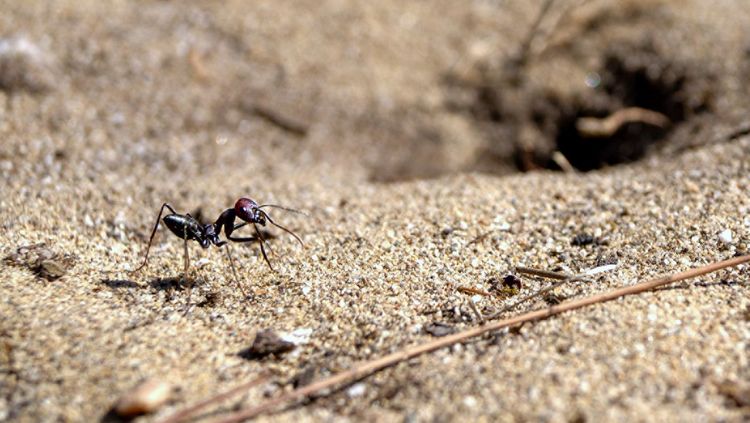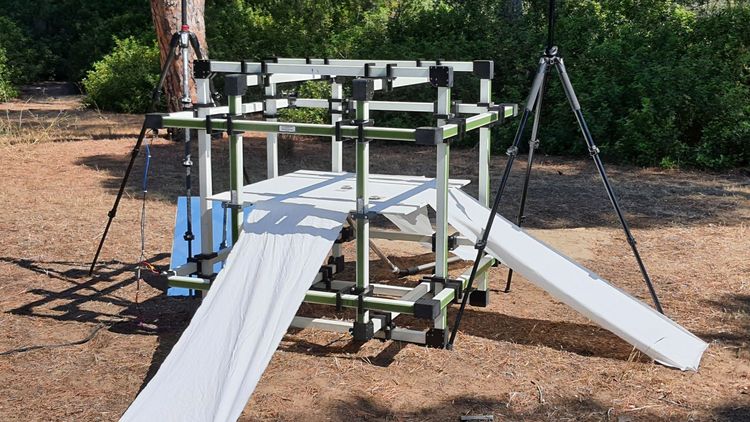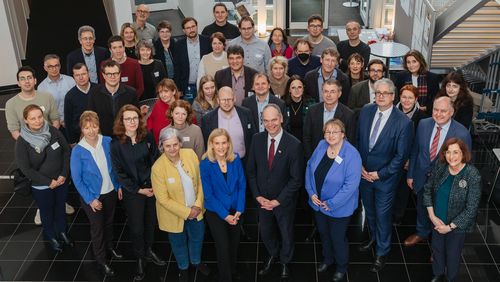Desert ants rely on a special component of the Earth's magnetic field to navigate. Their magnetic sense may be based on magnetic particles, according to a new study that has now been published in the journal Current Biology.
Desert ants of the Cataglyphis nodus species use the Earth's magnetic field for spatial orientation, but these tiny insects rely on a different component of the field than other insects, a research team led by Dr Pauline Fleischmann from the University of Oldenburg, Germany, reports in the journal Current Biology. As the team explains in its paper, this suggests that they also use a different mechanism for magnetoreception than most insects studied to date, including, for example, the famous monarch butterflies. The researchers suspect that magnetoreception in these desert ants is based on a mechanism involving tiny particles of the iron oxide mineral magnetite or other magnetic particles.
How exactly magnetoreception works in animals, and what physical mechanism it is based on is still the subject of lively debate among scientists. One hypothesis under discussion is a light-dependent quantum effect known as the radical-pair mechanism. Small songbirds and possibly also insects such as monarch butterflies are thought to use this mechanism. The Collaborative Research Centre "Magnetoreception and Navigation in Vertebrates" led by biologist Prof. Dr. Henrik Mouritsen at the University of Oldenburg has gathered substantial evidence supporting this hypothesis.
Another hypothesis is that in some animals magnetoreception is based on tiny magnetic particles in sensory or nerve cells that point to the magnetic North, in a similar way to a compass needle. There is now considerable evidence that both forms of magnetoreception occur in nature. Pigeons, bats and sea turtles, for example, appear to sense the geomagnetic field via magnetic particles.
Behavioural experiments can distinguish between different mechanisms of magnetoreception
Since the proposed mechanisms for magnetoreception are based on different physical principles, behavioural experiments can be designed to determine which mechanism is used by which animals. The scientists part from the premise that animals with a particle-based magnetic sense are sensitive to the north-south direction of the geomagnetic field, in other words its "polarity", whereas those that rely on the radical-pair mechanism perceive the inclination, i.e. the angle between the geomagnetic field lines and the Earth's surface.
To gain more insights into how the magnetic sense of desert ants functions, Fleischmann, together with Dr Robin Grob (now at the Norwegian University of Science and Technology, Trondheim, Norway), Johanna Wegmann and Prof. Dr. Wolfgang Rössler from the University of Würzburg, Germany, investigated which component of the Earth's magnetic field these insects are able to detect: the inclination or the polarity. In 2018, while Fleischmann was doing her PhD at the University of Würzburg, the research team discovered that desert ants possess a magnetic sense. She has been a Research Fellow in the Oldenburg CRC since 2022.
In the current study, the researchers exposed ants from a colony in Greece to various manipulated magnetic fields. For this, they set up Helmholtz coils above the entrance of the nest and guided ants that emerged from the nest through a tunnel to an experimental platform at the centre of the coils where they were then filmed while performing their "learning walks" – a behaviour that desert ants display when they leave their nest for the very first time. Fleischmann had discovered while completing her doctoral project that the ants use the Earth's magnetic field to memorise the direction of the nest entrance during these learning walks: they repeatedly interrupt their forward movement to stop and look in the direction of the nest entrance. The researchers suspect that the ants are using the magnetic field to train their visual memory. The results of a study on the ants' brain development which the team recently published in the scientific journal PNAS appear to confirm this.
Changing the inclination had no effect on the ants' behaviour
In the current study, the researchers exposed the ants to artificial magnetic fields that pointed in a different direction to the Earth's natural magnetic field. The team found that if they only changed the vertical component of the field, the inclination, this had no effect on the direction of the ants' gaze: they continued to look towards the location of the nest entrance during their learning walks. However, if the polarity of the field, i.e. the north-south axis, was rotated by 180 degrees, the ants surmised that the nest entrance was at a completely different location.





